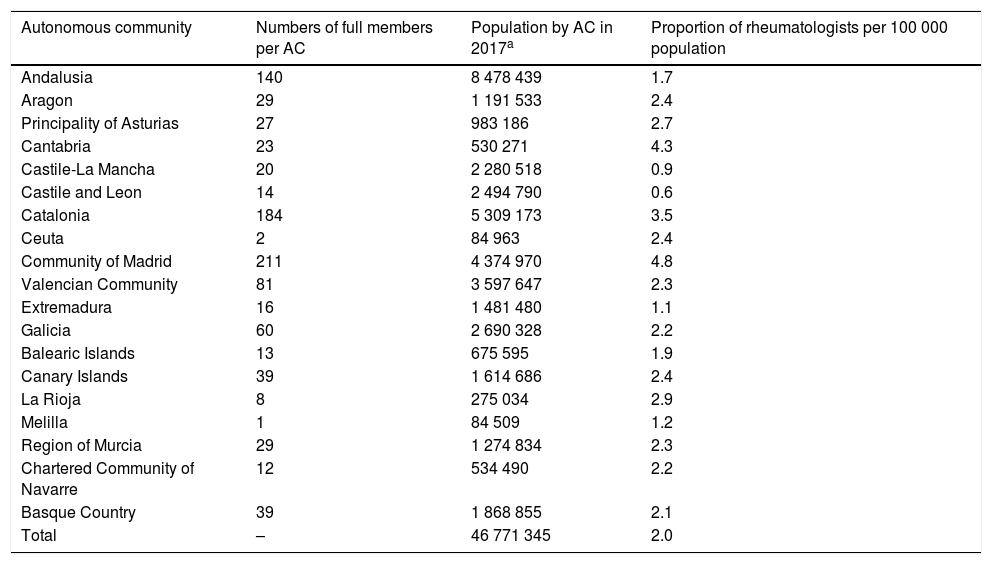The commission on professional relations, private practice and services to the members of the Spanish Society of Rheumatology (SER) is searching to offer updated data on the status of our specialty in Spain. For this purpose, we commissioned the Research Unit of the SER to estimate the number of rheumatologists currently available in Spain per 100 000 population, assuming that 95% of the rheumatologists are members of the SER.
The number of specialists available per 100 000 population is an indicator of the health recourses that are utilized for the evaluation and organization of health care systems.1,2 While this data is objective, there is certain controversy as to its true utility since there is no suitable standard in our neighboring countries.3
Table 1 shows the number of rheumatologists per 100 000 population in each of the Spanish autonomous communities and the sum total. The figure for Spain as a whole reaches a ratio of 2 rheumatologists per 100 000 population. The autonomous community with the highest ratio is the Community of Madrid, with 4.8 rheumatologists per 100 000 population, and the lowest rate is that of Castile and Leon, with 0.6 rheumatologists per 100 000 population.
Rheumatologists by Spanish Autonomous Community. Rate of the Number of Rheumatologists per 100 000 Population.
| Autonomous community | Numbers of full members per AC | Population by AC in 2017a | Proportion of rheumatologists per 100 000 population |
|---|---|---|---|
| Andalusia | 140 | 8 478 439 | 1.7 |
| Aragon | 29 | 1 191 533 | 2.4 |
| Principality of Asturias | 27 | 983 186 | 2.7 |
| Cantabria | 23 | 530 271 | 4.3 |
| Castile-La Mancha | 20 | 2 280 518 | 0.9 |
| Castile and Leon | 14 | 2 494 790 | 0.6 |
| Catalonia | 184 | 5 309 173 | 3.5 |
| Ceuta | 2 | 84 963 | 2.4 |
| Community of Madrid | 211 | 4 374 970 | 4.8 |
| Valencian Community | 81 | 3 597 647 | 2.3 |
| Extremadura | 16 | 1 481 480 | 1.1 |
| Galicia | 60 | 2 690 328 | 2.2 |
| Balearic Islands | 13 | 675 595 | 1.9 |
| Canary Islands | 39 | 1 614 686 | 2.4 |
| La Rioja | 8 | 275 034 | 2.9 |
| Melilla | 1 | 84 509 | 1.2 |
| Region of Murcia | 29 | 1 274 834 | 2.3 |
| Chartered Community of Navarre | 12 | 534 490 | 2.2 |
| Basque Country | 39 | 1 868 855 | 2.1 |
| Total | – | 46 771 345 | 2.0 |
The results obtained in the analysis, using the database of members of the SER, assuming that 95% of the rheumatologists are members, establish a rate of 2.16 rheumatologists per 100 000 population, which, in practice, signifies the stagnation in the availability of rheumatologists in Spain. Our results are in keeping with those of the work carried out at the University of Las Palmas in the Canary Islands with data from 2006.4 The results we encountered are also similar to those reported by Pérez and López-Valcárcel in 2008, who moreover offer ratios according to autonomous communities.5 The figures presented here are the first offered for Spain from those works. The analysis carried out in this report does not enable us to determine the reasons for this stagnation in the number of rheumatologists in Spain since 2008, but a possible factor could be the present economic circumstances, with major restrictions.
This situation occurs in a context of an aging population, a determining factor that has motivated, among others, the introduction of EPISER 2016, a project that studies the prevalence of rheumatic diseases 16 years after launching the first version of the same study.6 The increasing prevalence of rheumatic diseases in a context of an aging population can translate into an increase in the demand for health care and into the need for more human recourses to attend to this situation.7,8 The data obtained in EPISER, in combination with the results of this work, may be useful in decision making in the context of health systems.
This report has certain limitations. Although the database utilized is based on the information provided by members of the SER, there can be some imprecisions, aside from the margin of error, which has been considered minimal. For the analysis of these results, we must take into account that it has been assumed that 95% of the rheumatologists in Spain are members of the SER and are included in the organization's database. A deviation of 10% (that is, that there were another 95 rheumatologists not included in the database of members of the SER) would suppose that the number of rheumatologists per 100 000 population in all of Spain could reach 2.2. To achieve 2.5 rheumatologists per 100 000 population in all of Spain, there would have to be 221 rheumatologists not associated with the SER.
In conclusion, although the interpretation of the number of specialists per 100 000 population may be controversial, the results of this report enable us to evaluate how rheumatology is facing the health care challenges that are being presented in recent years, and that will not be detained in the near future. The potential sociodemographic changes, which could affect the prevalence of rheumatic diseases, make further work necessary to enable us to analyze not only the present situation, but to also consider the future outlook of rheumatology in Spain.
Please cite this article as: Sanchez-Piedra C, Yoldi B, Valero M, Andreu JL, Díaz-González F, Gómez-Reino JJ, en representación del Grupo de trabajo BIOBADASER Fase III. Estado de la reumatología en España en 2017: 2,0 reumatólogos por 100.000 habitantes. Reumatol Clin. 2018;14:311–312.







